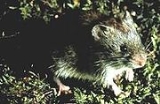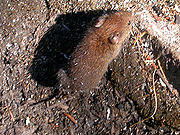
Southern Red-backed Vole
Encyclopedia
The Southern Red-backed Vole or Gapper's Red-backed Vole (Myodes gapperi) is a small slender vole
found in Canada
and the northern United States
. It is closely related to the Western Red-backed Vole
(Myodes californius), which lives to the south and west of its range and which is less red with a less sharply bicolored tail.
These voles have short slender bodies with a reddish band along the back and a short tail. The sides of the body and head are grey and the underparts are paler. There is a grey colour morph in the northeast part of their range. They are 12–16.5 cm (4.7–6.5 in) long with a 4 cm tail) and weigh about 6–42 g; avg. 20.6 g (0.21–1.48 oz; avg. 0.72 oz).
 These animals are found in coniferous, deciduous
These animals are found in coniferous, deciduous
, and mixed forests, often near wetlands. They use runways through the surface growth in warm weather and tunnel through the snow in winter. They are omnivorous feeding on green plants, underground fungi
, seeds, nuts, roots, also insects, snails, and berries. They store roots, bulbs, and nuts for later use.
Predators include hawk
s, owl
s, and mustelids.
Female voles have two to four litters of two to eight young in a year.
They are active year-round, mostly at night. They use underground burrows created by other small animals.
Vole
A vole is a small rodent resembling a mouse but with a stouter body, a shorter hairy tail, a slightly rounder head, smaller ears and eyes, and differently formed molars . There are approximately 155 species of voles. They are sometimes known as meadow mice or field mice in North America...
found in Canada
Canada
Canada is a North American country consisting of ten provinces and three territories. Located in the northern part of the continent, it extends from the Atlantic Ocean in the east to the Pacific Ocean in the west, and northward into the Arctic Ocean...
and the northern United States
United States
The United States of America is a federal constitutional republic comprising fifty states and a federal district...
. It is closely related to the Western Red-backed Vole
Western Red-Backed Vole
The Western Red-Backed Vole is a species of vole in the family Cricetidae. It is found in California and Oregon in the United States and lives mainly in coniferous forest...
(Myodes californius), which lives to the south and west of its range and which is less red with a less sharply bicolored tail.
These voles have short slender bodies with a reddish band along the back and a short tail. The sides of the body and head are grey and the underparts are paler. There is a grey colour morph in the northeast part of their range. They are 12–16.5 cm (4.7–6.5 in) long with a 4 cm tail) and weigh about 6–42 g; avg. 20.6 g (0.21–1.48 oz; avg. 0.72 oz).

Deciduous
Deciduous means "falling off at maturity" or "tending to fall off", and is typically used in reference to trees or shrubs that lose their leaves seasonally, and to the shedding of other plant structures such as petals after flowering or fruit when ripe...
, and mixed forests, often near wetlands. They use runways through the surface growth in warm weather and tunnel through the snow in winter. They are omnivorous feeding on green plants, underground fungi
Fungus
A fungus is a member of a large group of eukaryotic organisms that includes microorganisms such as yeasts and molds , as well as the more familiar mushrooms. These organisms are classified as a kingdom, Fungi, which is separate from plants, animals, and bacteria...
, seeds, nuts, roots, also insects, snails, and berries. They store roots, bulbs, and nuts for later use.
Predators include hawk
Hawk
The term hawk can be used in several ways:* In strict usage in Australia and Africa, to mean any of the species in the subfamily Accipitrinae, which comprises the genera Accipiter, Micronisus, Melierax, Urotriorchis and Megatriorchis. The large and widespread Accipiter genus includes goshawks,...
s, owl
Owl
Owls are a group of birds that belong to the order Strigiformes, constituting 200 bird of prey species. Most are solitary and nocturnal, with some exceptions . Owls hunt mostly small mammals, insects, and other birds, although a few species specialize in hunting fish...
s, and mustelids.
Female voles have two to four litters of two to eight young in a year.
They are active year-round, mostly at night. They use underground burrows created by other small animals.
External links
- Southern Red-backed Vole at Nature Works

